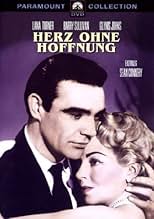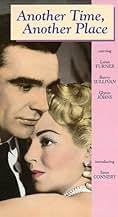NOTE IMDb
5,8/10
945
MA NOTE
Ajouter une intrigue dans votre langueAn American war correspondent falls in love with a BBC reporter, but their relationship seems doomed from the start.An American war correspondent falls in love with a BBC reporter, but their relationship seems doomed from the start.An American war correspondent falls in love with a BBC reporter, but their relationship seems doomed from the start.
- Réalisation
- Scénario
- Casting principal
Jack Armstrong
- Reporter
- (non crédité)
Mabel Etherington
- Woman at Inn
- (non crédité)
Lee Fenton
- Reporter
- (non crédité)
Aidan Harrington
- Man at Inn
- (non crédité)
Avis à la une
Whilst on assignment in a very 1950s-looking WW2 London, a plastic-haired US ace-journo' (Turner) and an impossibly baby-faced Cornish ace-journo' (Connery) are lost in the throws of a torrid affair, despite the disapproval of colleagues (stiff-upper-lip Longdon, laconic James). However, even as declarations of undying love are uttered, dark clouds loom in the form of Turner's newspaper boss and erstwhile lover Sullivan, and Connery's shock disclosure that he has a wife and child tucked away in his native Cornish village. When Connery is killed in a plane crash, a devastated Turner makes a pilgrimage to his native Cornwall where her path crosses that of his wife and child...
Risible weepy, serving as a star vehicle for Lana and an early showcase for the handsome young Connery, both of whom fail miserably to convince. Turner seems to possess only three facial expressions, even when trying to stay upright in her stilettos as she totters round 'St. Giles' (actually Polperro) - witness her horribly 2-D efforts to comfort Martin Stephens after his nightmare. Meanwhile Connery's description of his Cornish fishing village birthplace is delivered in such a rich Edinburgh brogue as to be quite giggle-some.
So often the case with British cinema of the 40s and 50s, it's the support players who steal the show - Glynis Johns' is a beautifully judged and modulated depiction of a woman recovering from grief. Her resolute kindness, generosity and warmth make her reaction to the final reel revelations all the more believable. Sid James shines as a world-weary American journalist trying to juggle loyalties, and Stephens' post-nightmare scene is desperately convincing.
Sadly however, excellent support playing, and beautiful location shooting are just not enough to save this overwrought turkey.
Risible weepy, serving as a star vehicle for Lana and an early showcase for the handsome young Connery, both of whom fail miserably to convince. Turner seems to possess only three facial expressions, even when trying to stay upright in her stilettos as she totters round 'St. Giles' (actually Polperro) - witness her horribly 2-D efforts to comfort Martin Stephens after his nightmare. Meanwhile Connery's description of his Cornish fishing village birthplace is delivered in such a rich Edinburgh brogue as to be quite giggle-some.
So often the case with British cinema of the 40s and 50s, it's the support players who steal the show - Glynis Johns' is a beautifully judged and modulated depiction of a woman recovering from grief. Her resolute kindness, generosity and warmth make her reaction to the final reel revelations all the more believable. Sid James shines as a world-weary American journalist trying to juggle loyalties, and Stephens' post-nightmare scene is desperately convincing.
Sadly however, excellent support playing, and beautiful location shooting are just not enough to save this overwrought turkey.
I found myself 'fast-forwarding' thru the last half hour. The script missed some great chances at early character development, which left the 'talent' struggling to pull this movie together. Their characters lacked depth and motivation in the later going, and the 96 minutes seemed much longer.
I'm still trying to figure out exactly what is the most ridiculous thing about this 1958 Paramount melodrama - the notion of Lana Turner as an ace war correspondent, or Sean Connery's eyebrows. Turner plays Sara Scott, one of those movie journalists who remains gainfully employed despite never letting work get in the way of their personal life. She swans around wartime London in a fur coat, perfectly coiffed and oblivious to the realities of modern warfare although, to be fair, it's not difficult for her not to notice when director Lewis Allen has chosen to mostly omit it from the mise-en-scene. Other than a sequence showing sappers defusing an unexploded V2 rocket, and Scott's hired help making a passing reference to rationing, there's no indication that this is a city that's been at war for nearly 6 years. There's no bombed out buildings, no indication of food, gas or clothing shortages, and barely anyone in uniform on the streets. As a peroxide blonde society lady who spends her time lunching, loving and shopping on 5th Avenue, Turner is entirely convincing. As a highly rated journalist ready to fly off at a moment's notice to whichever battle front her editor deems her presence and writing talents to be essential, she's somewhat less plausible than Steven Seagal tackling Shakespeare. Which brings us to Mr Connery's eyebrows. They are both a wonder and a mystery and put Robert Pattinson's brow hair to shame. His are wider but inexpressive and just sit there above his eyes. Connery's, in contrast, are longer and undulate like two strips of dark brown deep shag carpeting strapped to the back of a couple of adult earthworms. They're so impressive they actually distract attention from his luxuriant head of hair which to anyone used to the older, more follically challenged Connery, is a talking point in itself. ANOTHER TIME ANOTHER PLACE was not the 28 year old's first movie but it was the first time his name had been billed in such close proximity to the film's stars, and clearly no one had considered that a little personal grooming might be in order to reflect his new status as love interest to a bona fide Hollywood star. His agent might also have found a tactful way to suggest that having Connery's character, with his distinct Scottish accent, wax lyrical at great length about his idyllic home town on the coast of Cornwall, might not be the most convincing. But even shifting location and pruning his eyebrows would not have prevented this turgid drama from dissolving into a pool of smelly sludge. Nothing about it rings true and no one does anything to evince our interest or sympathy. It's just a bust. Check out more of my reviews at http://thefilmivejustseen.blogspot.com/
Everybody around here seems to be criticizing this fine piece of melodrama. It feels like a duty to say some good things to save it right away. I only heard about the title yesterday from Amazon, and then, in the afternoon, a friend of mine offered to lend it to me. I appreciated the coincidence. I've just finished watching it, and must confess I really enjoyed the show. The image is great, Lana Turner is beautiful. I will accept the fact that it's not as original as other melodramas, but it definitely uses all the ropes we love about this kind of movies. So my mark here is seven, I had a great time and I would advise anyone interested in melodramas to have a look at it on a sunny day, just before going to the beach. And dream while watching seagulls in the sky.
Another Time, Another Place is a multi-dimensional movie. Keeping in mind that it is fifty-eight years old, I imagine the storyline and character building was fairly innovative. Still today, the acting, script, and directing were relevant enough on a general level and pulled me in. I felt drawn towards each character and their individual plights, albeit some more than others. Emotions emanated off the screen, and some scenes were very powerful. While this isn't the best movie of all time, and arguably may not be the peak of Turner's and Connery's careers, it is certainly a heartfelt film that deserves respect.
Le saviez-vous
- AnecdotesDuring the shooting of the movie in England, Sir Sean Connery was confronted by Johnny Stompanato, an ex-marine turned mob enforcer, who was in an abusive relationship with Lana Turner. At the time, Connery and Turner got along very well, so much that when Stompanato found out about it, he suspected that they were having an affair. Stompanato, who was notorious for his jealousy and violent tendencies, then stormed to the set and threatened Connery with a gun. But he quickly disarmed Stompanato and forced him from the set. Following that incident, Stompanato was deported by Scotland Yard. Shortly after he arrived in the USA, he met his end at the hands of Turner's teenage daughter Cheryl, who fatally stabbed him in self-defence while he was beating her mother. Connery, who was filming Darby O'Gill et les farfadets (1959) at the time of the latter incident, behaved very cautiously when he walked the streets of Los Angeles, because it was rumoured that a mobster made him responsible for Stompanatos death. That caused him to avoid the USA for several years.
- GaffesThe story takes place in 1945, but all the women's hairstyles and clothes, particularly the high fashion designs worn by Lana Turner, are strictly 1958.
- Citations
Kay Trevor: Music has such a way of bringing back memories doesn't it? Does it remind you of anyone?
- ConnexionsReferenced in Opération Tonnerre (1965)
- Bandes originalesAnother Time, Another Place
Written by Jay Livingston and Ray Evans
Meilleurs choix
Connectez-vous pour évaluer et suivre la liste de favoris afin de recevoir des recommandations personnalisées
- How long is Another Time, Another Place?Alimenté par Alexa
Détails
- Date de sortie
- Pays d’origine
- Langue
- Aussi connu sous le nom de
- Another Time, Another Place
- Lieux de tournage
- Sociétés de production
- Voir plus de crédits d'entreprise sur IMDbPro
- Durée1 heure 31 minutes
- Couleur
- Rapport de forme
- 1.85 : 1
Contribuer à cette page
Suggérer une modification ou ajouter du contenu manquant

Lacune principale
By what name was Je pleure mon amour (1958) officially released in India in English?
Répondre






























